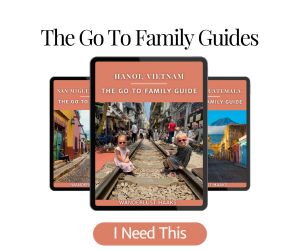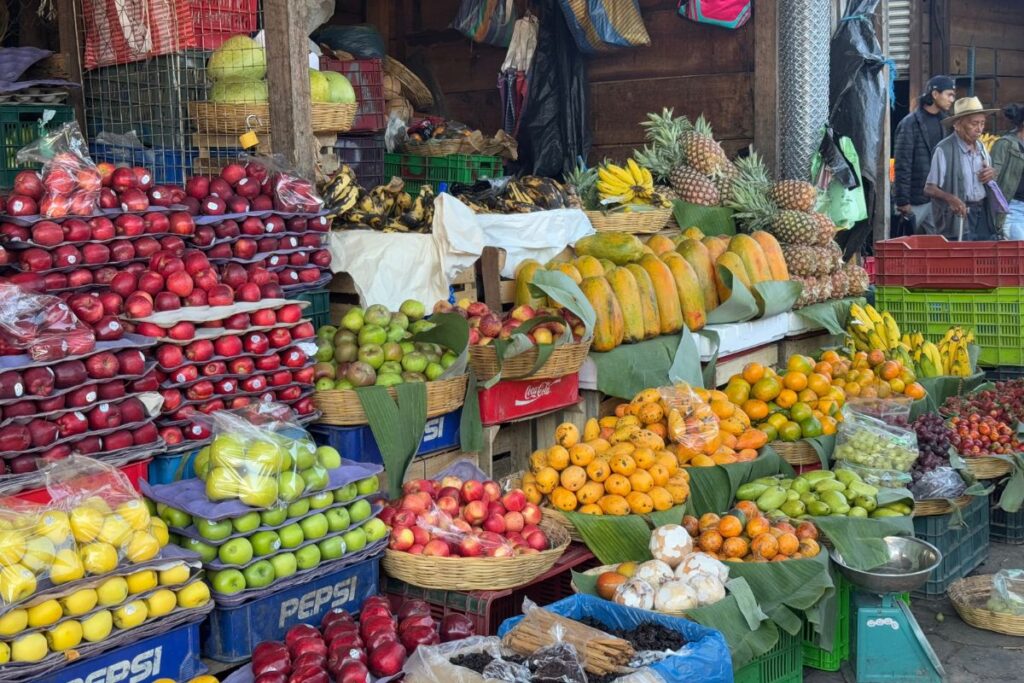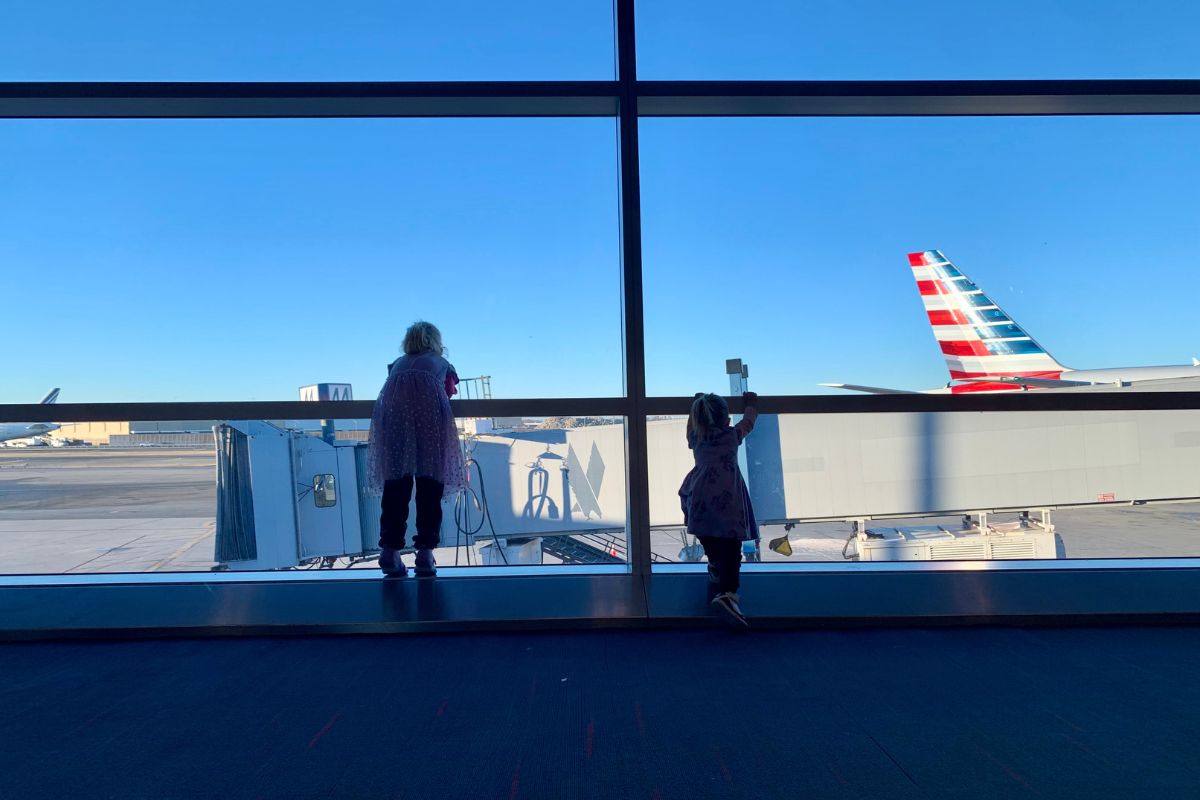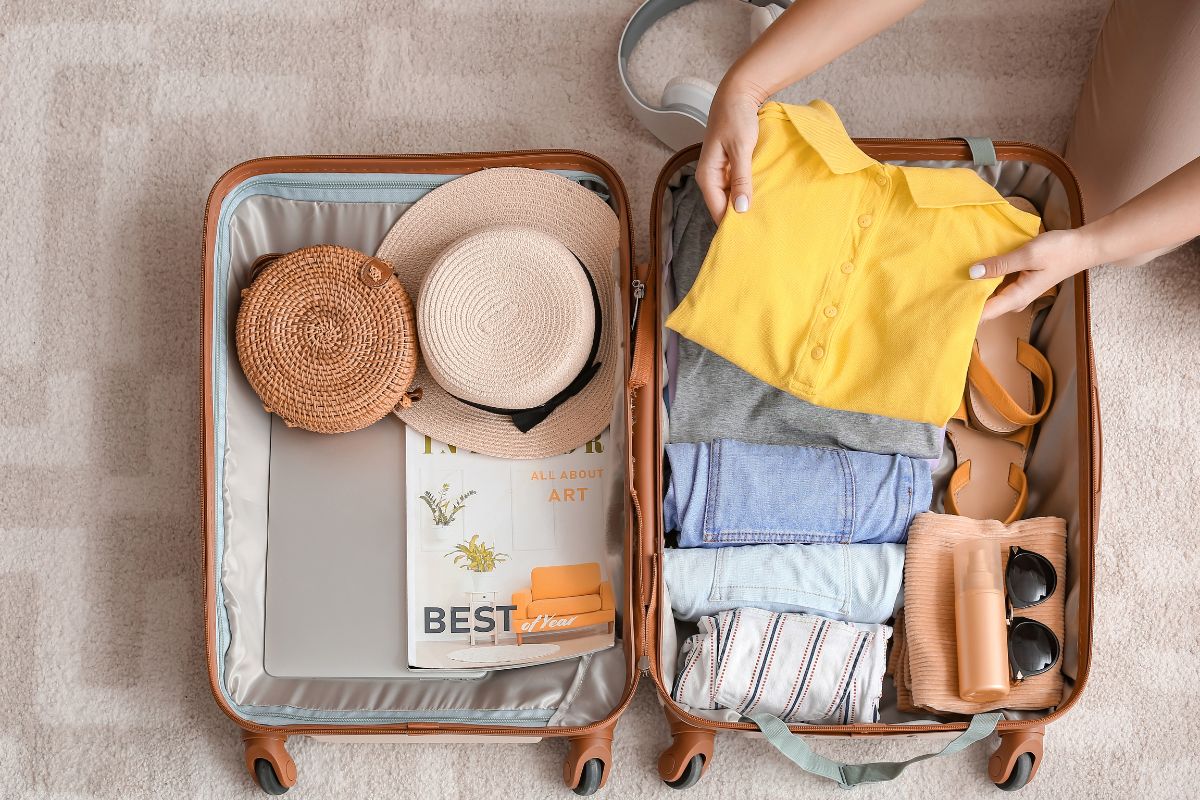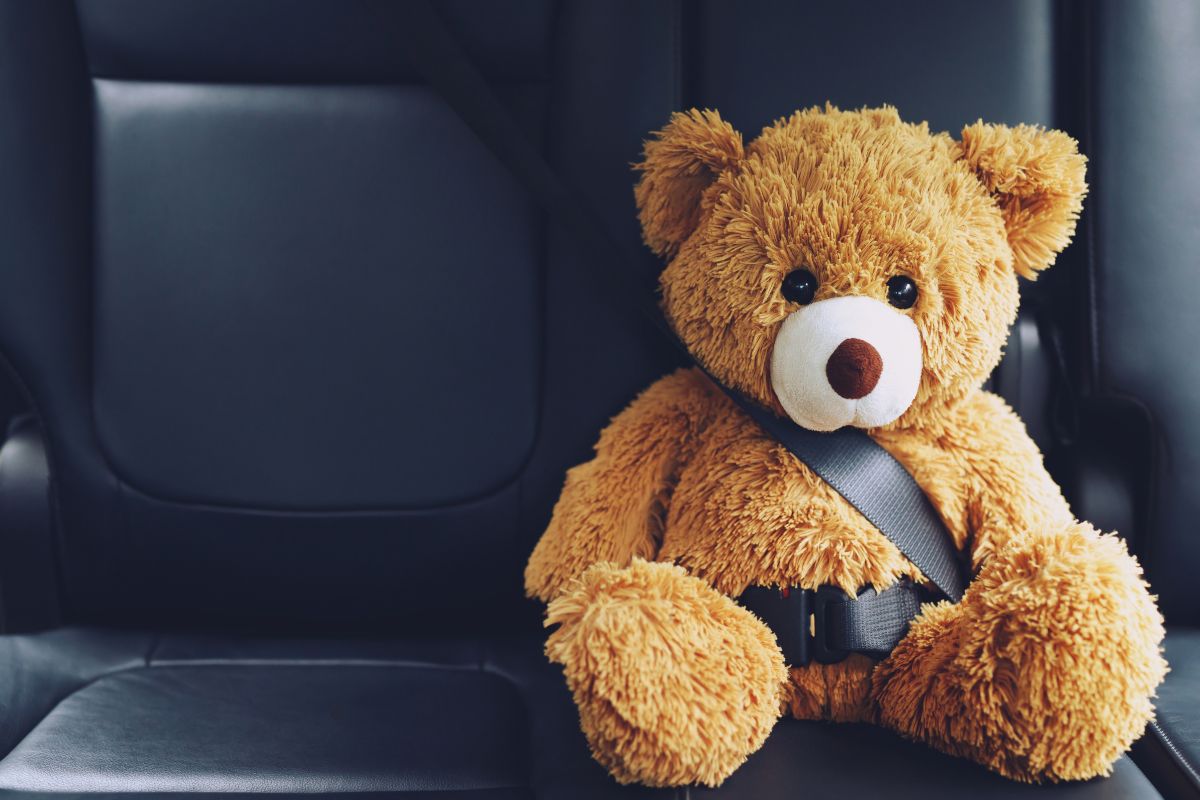If you’ve ever found yourself daydreaming about ditching routines, grabbing your kids, and actually seeing the world without racing through it all, you’re not alone. This post is for you.
We started our slow family travel journey in September 2024 because we were craving something different. My husband and I wanted more time together. We were burned out from fast-paced jobs and fast-paced vacations that left us needing a break from the break. We weren’t looking for another bucket list trip, we were looking for a full reset.
So we decided to take a family gap year. Not just a long vacation, but a full shift in how we lived and parented. We swapped schedules and school drop-offs for new cultures, local playgrounds, and shared breakfasts with no alarms. It wasn’t perfect. But it’s been worth it.
This isn’t a highlight reel. It’s an honest guide to what families really want to know when they’re thinking about long-term travel with kids. These are the questions people ask us all the time, and they’re probably the same ones you’ve been quietly googling after the kids go to bed. I get it. We were there too.
In this post, I’ll walk you through the ten biggest questions we had before we left—and the answers we’ve learned while traveling full-time with two young kids. I’m sharing everything I wish I knew when we were sitting in that exact same spot, asking the same things.
Let’s dive in and talk about what slow family travel really looks like, what it costs, how you plan for it, and whether it’s actually safe and doable for a regular family.
You can do this. I promise. But let’s make sure you get all the information you need to decide for yourself
1. What is slow family travel and how is it different from a regular vacation?
If you have been searching for a better way to travel with kids, something that feels more connected and a lot less chaotic, then slow family travel might be exactly what you have been looking for.
When our family made the decision to leave behind the fast-paced vacations and start traveling slowly, everything changed. Instead of packing up every few days, we now stay in one place for at least two weeks, sometimes longer. This gives our kids the time to adjust, rest, and play. It gives us the space to actually get to know a place, not just pass through it.
This is not the kind of travel where you try to check off all the tourist spots in one trip. We have done that before. It looked fun in photos but left us feeling more tired than we were before we left. That is what pushed us toward this slower lifestyle. We did not want to come home from every trip needing to recover. We wanted something different for our family.
With slow family travel, we build daily routines in new places. We shop at local markets. We find coffee shops where the baristas recognize us. The kids pick a favorite playground and go back to it again and again. We are not chasing one experience after the next. We are just living, together, in a new place.
This way of family travel also supports how we approach unschooling. Our kids learn from the world around them. They ask questions at temples, count currency at shops, watch how people live in different cultures and start to understand there are many ways to live a good life. That kind of learning cannot happen in a classroom or on a rushed vacation. It comes from time and curiosity, and slow travel gives us both.
One of the most surprising parts? It is more affordable than you think. When you stay in one place longer, you get better deals on housing. You are not paying for constant transportation or eating out every night. We often rent homes by the month and cook our own meals. Not only does it help our budget, it also helps our kids feel more settled.
This is not about giving up adventure. It is about doing one meaningful thing a day and letting that be enough. A walk through the market. A conversation with a local shop owner. A beach day with no schedule. These are the moments that stick with us.
Slow family travel is not a vacation. It is a lifestyle choice that invites more presence, more connection, and more learning into your days. It lets you travel as a family without the burnout. Slow family travel lets your kids truly experience the world, not just see it through a car window.
2. How did you know your family was ready for a family gap year?
You know how you sometimes feel like you are stuck on a treadmill you can’t step off? That’s exactly where we were. After ten years of working as PAs, moving across the country twice between Arizona and North Carolina, and going through IVF, we just kept spinning and feeling more exhausted. We noticed something was missing.
Work was never on my side. Asking for time off felt impossible. It was all “no” or “reschedule.” That pressure hit its breaking point after a family trip to South Africa in 2023. We were there for three weeks and saw just a fraction of what South Africa has to offer. It felt like we were rushing through life instead of living it.
That trip planted a seed. We all came home craving more. More time together. More meaningful moments. We wanted connection, not pictures. We wanted experience, not exhaustion. And we wanted simplicity, not everything planned down to the minute.
Here is something I discovered from talking to other families who take gap years:
Parents often describe a kind of internal tug. They feel ready when they start asking themselves, “Why are we doing it this way? Isn’t there more to life together?” It is not about grand gestures. It is about subtle cracks in your day that feel like alarms. Your kid asks for more time with you. You dread your daily rhythm. You feel certain this is not where long term life is supposed to end up.
That awareness that gentle, insistent whisper that is how you know you might be ready for a family gap year. And yes, it can feel overwhelming at first. But the good news is you do not have to have every single detail figured out before you start. You just need the spark. The rest? We figured it out as we went.
If you are sitting here wondering if your family is ready for this shift, here is what I want you to know right now: The fact that you are thinking about it could be the clearest sign you already are.
3. How do you even begin planning for long-term travel with kids?
Planning long-term travel with kids might sound like this huge, overwhelming project—but it does not have to be. For us, it started with one simple step. We opened a high-yield savings account just for the trip. Every month, after covering our regular bills and investments, we added whatever we could into that account. It helped to have it separate from everything else. Mentally, that money had a purpose. It was our freedom fund.
Then we got practical. We made sure we had the right financial tools in place. That meant signing up for a travel credit card that earns points and has solid travel protections. We also opened a debit card with no foreign transaction fees, which makes a big difference when you are withdrawing cash from ATMs abroad. A few good options include Charles Schwab for banking and Capital One or Chase Sapphire for credit, but the right one depends on your personal financial situation.
From there, we started tracking everything. We set up a spreadsheet to monitor what we were saving each month, what our fixed expenses were, and what we needed to pay off or pause before leaving. You do not want to be halfway across the world and suddenly realize your car loan or your phone bill is still charging you. It sounds obvious, but it is easy to overlook the little things.
We began planning about a year ahead. That gave us enough time to figure out what to do with our house, how to handle our car, and what our childcare or schooling would look like on the road. We also had to look at things like health insurance, what vaccinations the kids might need, and how to organize our important documents.
But we did not try to plan every single step of the year. That would have been impossible and, honestly, unnecessary. We just booked the first few legs and left room to adapt. And that flexibility ended up being a huge gift. We originally thought we would be in South America for months. But when the weather and costs started shifting, we pivoted and flew to India instead. That would have been so hard if we had locked ourselves into a fixed itinerary.
I also recommend creating a shared folder in your Google Drive or Dropbox to keep digital copies of everything—passports, insurance cards, backup credit cards, vaccination records, and confirmations. And screenshot the most important ones on your phone in case Wi-Fi is spotty.
Planning for long-term family travel is about balancing preparation with trust. You want a strong foundation, but you also want to leave space for real life to unfold. If you try to map out every detail, you will burn out before you even leave. Start with the basics. Know your numbers. Pick a starting point. And let the rest come together piece by piece. You do not have to know everything today. You just have to start.
4. How do you afford this kind of travel and what does travel budgeting look like?
One of the first questions I get is, “How can your family afford to travel full time?” And I get it. It seems like this dreamy, expensive thing. But here’s the truth. Once you slow down and change how you travel, the numbers start to work out in ways most people don’t expect.
We saved around one hundred thousand dollars before leaving, but our goal was to spend less than half of that over the year. So far, we are on track. Our monthly travel budget usually lands somewhere between two thousand five hundred and three thousand dollars depending on the country. That covers everything—housing, food, transportation, activities, insurance, and extras for the kids.
The biggest costs are usually housing and flights. So we focused on bringing those two down first. We stay longer in each place, usually for a full month, which means we get a better deal on rent. Monthly discounts on Airbnb can be pretty generous, but we also look outside of Airbnb. We have found great homes through Facebook groups and local listings. When you go directly through a host or a real estate agent, you can often avoid the booking fees entirely.
We also limit flights. Flying with kids is expensive and exhausting. So instead of country-hopping every few weeks, we take trains and buses when possible. In Southeast Asia, the trains are efficient and affordable. Our go to website for is 12go.asia. In Mexico and Guatemala, we used buses to get around for a fraction of the price of flying. The bonus is that our kids get to see more of the country that way too.
We cook most of our meals at home, which is not only cheaper but also helps the kids feel more settled. I’m not talking about making every single thing from scratch, but we usually do breakfast and dinner at home and grab lunch or a snack while we are out exploring. Grocery shopping in a new country is one of our favorite ways to experience local life anyway.
We also budget based on location. Some countries stretch your dollar a lot farther than others. In Southeast Asia, we found that we could stay well below our target monthly spend, even with private healthcare and daily outings. In Latin America, things are still manageable but sometimes a little higher depending on flights and accommodation.
If you are trying to figure out what your own budget might look like, start by looking at the average cost of living for families in places you are interested in. Websites like Numbeo or travel Facebook groups can give you a solid baseline. Then layer on what is realistic for your own lifestyle and comfort level.
Family travel does not have to be expensive. But you do need to be intentional. The more you slow down, the more affordable it becomes. You are not spending hundreds on hotels every few nights or burning through your budget on one week of restaurants and attractions. You are creating a new rhythm—one where your time and money actually stretch farther than you thought possible.
5. Is it safe to travel with kids long term?
Yes. It absolutely can be. But like anything else with kids, it takes a little preparation and a lot of trust in your instincts.
Before we started our slow family travel journey, we made an appointment at a local travel clinic to go over recommended vaccinations and region-specific precautions. They gave us solid information on what we might need depending on where we were going, including things like typhoid and hepatitis A. Some vaccines are required for entry into certain countries, especially if you’re coming from a region with known outbreaks, so it is always worth checking in advance.
We also got our paperwork in order early. We keep digital copies of our passports, travel insurance documents, and emergency contacts on our phones and in a shared folder we can access offline. I cannot tell you how helpful this has been, especially when Wi-Fi is spotty or our SIM card has not activated yet.
We travel with insurance that includes emergency and medical evacuation coverage. We use SafetyWing and it has served us well. Our daughter once got her foot caught in the spokes of a rental bike. It was one of those terrifying parenting moments. We ended up at a hospital where she was seen by a general doctor, then a specialist, and had an X-ray before they splinted her foot. It all felt professional and calm, and we were fully reimbursed for the cost. I felt genuinely supported and safe through the process.
We always aim for private hospitals and clinics when we need care. In many countries, private care is very affordable and much faster than public systems. I usually do a quick search on local expat forums or ask hosts for recommendations ahead of time, just in case something comes up.
Another thing we think about is access to basic medication. Pharmacies abroad carry a lot of what we are used to, but sometimes the brands and names are different. I pack a small kit with kid-safe medicine for pain relief, allergies, motion sickness, and mild stomach bugs. It helps to have what you need ready to go while you are learning your way around.
When choosing where to go, we think about health care access, transportation, cleanliness, and how we would handle a medical situation in that place. But we also do not let fear stop us from going. Most of the world is more prepared for families than people realize.
Traveling with kids long term will never be completely predictable. But neither is staying home. We do what we can to plan, protect, and prepare. And then we show up with the knowledge that kids are incredibly adaptable—and most of the world is filled with kind, helpful people who want to see you and your family thrive.
6. What about school? How do you handle unschooling or education while you travel?
This is probably the number one question I get when people find out we are traveling full time with kids. The short answer is we are doing a mix of unschooling and homeschooling, and it has been one of the most rewarding parts of this whole experience.
Our daughter is almost six, and right now she learns through a blend of structured activities and real-world life. She has workbooks for reading, writing, and math that we use a few times a week when it makes sense. But more often, her learning comes through everyday experiences. She helps us read menus in new languages and counts out change at local markets. She notices religious practices and cultural differences and asks thoughtful questions about what she sees.
We follow her lead and stay flexible. That is what unschooling is all about. It is child-led learning based on interest and curiosity, not a rigid curriculum. It might look different for every family. For us, it means we do not sit down for lessons at the same time every day. Instead, we build learning into our daily rhythm. When we visited India, she wanted to know more about the colorful statues and ceremonies, so we found YouTube videos that explained Hindu festivals and read simple articles together. Later, we visited a local temple and she remembered everything she had just learned. That kind of connection sticks in a way worksheets never did for me growing up.
We also teach life skills that traditional school often skips. She helps with grocery shopping, tracks how many days we have until we move again, and even helps make basic decisions about where we stay or what we eat. She is learning to communicate across cultures, try new foods, and handle change. These are not things we could teach at home in the same way.
One thing I always tell parents is that worldschooling does not mean giving up on education. It just looks different. It is learning in motion. If your kids are a little older and you want more structure, there are amazing online programs and curriculum options you can carry with you. Some families do virtual school through their district. Others enroll in accredited homeschool programs. It is completely up to you.
For us, we decided to keep things simple. We want learning to feel joyful and connected to our actual lives. So far, it has been a great fit. We are not worried about falling behind. We check in with where she would be in school, and honestly, she is doing just fine. More than fine. She is learning about people, resilience, flexibility, and culture—things I did not learn until I was much older.
If you are considering long-term family travel and wondering how to handle school, know this. There is no one right way. The beauty of this lifestyle is that you get to figure out what works best for your family. You do not need to have it all mapped out before you leave. You just need to stay open and trust that learning will happen all around you. And it really does.
7. What do you pack for full-time travel with kids?
Packing for full-time family travel is one of those things that feels overwhelming at first, but over time you realize how little you actually need. We have learned that keeping it minimal but functional is the way to go. If something does not serve more than one purpose or bring real comfort, it stays behind. Check out everything we bring on our Amazon Store.
We travel with one large suitcase for all of our shared clothes. Inside, we use packing cubes to divide things up by person and category. This keeps everything organized and makes unpacking way easier, especially when we move every few weeks. We each have about a week’s worth of clothing, mostly lightweight and versatile pieces that we can mix and match. Since we tend to stay in warm climates, we mostly pack shorts, T-shirts, swimwear, a lightweight jacket for cooler nights, and one long outfit for places where modesty is needed.
We also bring one backpack for electronics—our laptops, cameras, chargers, headphones, and anything else we need to run our lives and work on the road. Another backpack is dedicated to the kids’ toys and activity supplies. We keep it simple here. You do not need much. The less you pack, the more creative they get.
We carry a child carrier instead of a stroller. Most sidewalks abroad are not made for strollers, especially in places like India, Mexico, or small towns with cobblestone streets. Our carrier makes it easy to navigate crowded streets, buses, and markets without struggling. We also bring a car seat vest for occasional car rides, which saves us from lugging around a bulky car seat.
Some other essentials that go everywhere with us:
- A sound machine. This has been with us since the baby days and it is still a must. It helps drown out street noise or new sounds in unfamiliar homes.
- A universal adapter. Different countries use different plugs, so this one small tool keeps all of our electronics charged.
- A small toiletry bag of basic medications and hygiene products, especially anything kid-specific that may not be easy to find abroad. We buy shampoo, toothpaste, and other basics locally once we arrive, unless we are going somewhere rural or remote.
There is a temptation to bring everything “just in case,” but trust me, less really is more. If we overpack, it only makes moving harder and more stressful. We try to pack for one season at a time and reevaluate every few months. If we find ourselves needing something specific, we usually find it locally or buy it secondhand.
My best advice is this: think through what makes your days easier and what your kids actually use. Bring those things and let the rest go. It is surprising how little we truly need to live well when we are traveling slowly and living more simply. And remember, your suitcase is not your safety net, your flexibility is.
8. How do you decide where to go and how do you choose family-friendly destinations?
Picking the right place is one of the most important parts of slow family travel. When you are staying in a place for a few weeks or even a month, you are not just looking for the perfect photo backdrop. You are looking for a place that feels livable with little kids in tow. And honestly, that takes a little digging and a lot of real talk with other families who have done it.
When we start looking at a new destination, we always think about weather first. Are we going during the rainy season? Is it going to be too hot for the kids to be outside? We check climate charts, local travel blogs, and even ask in family travel Facebook groups.
Next, we ask ourselves whether it has access to both nature and groceries. Our ideal spot is somewhere with a nearby market or grocery store and a place to walk outside every day. It might be a beach, a park, a lake, or a trail. Our kids need to move their bodies and so do we. But we also need access to bananas and rice and eggs without an hour-long commute.
Walkability and public transport come next. Is there a bus system or ride-share service? Are we going to need to rent a car, and if so, what does that actually cost? Some places make it easy to get around. Others are charming but not great with small children and backpacks.
We also check for visa accessibility. Can we get a visa easily online? How long can we stay? Is there a limit on the number of entries? We use government websites and travel forums for this. In some countries, you can stay for 30 to 90 days without much paperwork. Others require you to apply in advance or leave and re-enter. We do our research early so we are not scrambling later.
And probably the most important thing for us is whether there is a community of expats or worldschooling families. These people are our people. They understand what we are doing and often have amazing tips for housing, play spaces, and daily life. We use Facebook groups to search “expats in [city]” or “[country] with kids” and just start reading the conversations. If the group is active, that is usually a good sign. You do not always need a huge community, but having a few families around can make a big difference, especially when your kids are craving playmates or you need a real conversation with another adult.
We also look at things like proximity to an airport. If it takes three buses and a tuk tuk to get there, we usually skip it. That kind of journey with kids and bags just drains us. We want to land and get settled quickly.
9. What does daily life look like while you’re traveling?
It is slower. It is simpler. But it is still very much real life.
Our daily rhythm changes slightly depending on where we are, but there are a few things that stay the same. We always start by getting our bearings. When we land somewhere new, we spend the first day or two walking around the neighborhood to find the basics—the market, the playground, the best spot for coffee, and somewhere the kids can move their bodies. We usually do not plan anything big during those first few days. We just explore on foot and figure out how life works in that place.
Most mornings are slow. We wake up without alarms and ease into the day. Our kids might pull out their Paw Patrol toys or color while we make breakfast. Sometimes we go out for an adventure like a museum, a local class, or a beach morning. Other times, we hang out close to home, especially if the kids need rest or we need to catch up on laundry or groceries.
We aim for one or two small outings per day at most. It might be walking to a local market, checking out a free event, or finding a new park. Anything more than that, and it starts to feel like we are doing too much. Our kids are still young and thrive when there is time to rest and play freely.
When it rains, which happens a lot in Southeast Asia, we sometimes head to the malls. They often have indoor playgrounds and kid-friendly spaces that make the day feel fun without being chaotic. Other days, we stay in, play with toys, and let boredom work its magic. That is something I had to learn to be okay with—letting the kids be bored without rushing in to entertain them. They always find something to do eventually.
Evenings are pretty quiet. We cook dinner most nights, go for a walk if the weather is nice, or unwind with books or a movie. We try to maintain a bit of routine at bedtime, especially for our youngest, because it helps everyone feel settled no matter where we are in the world.
Slow family travel is not about seeing as much as possible. It is about building a version of daily life that feels good for your family, wherever you are. Some days are magical. Some days are ordinary. But that balance is what keeps this lifestyle sustainable. We are not chasing constant stimulation. We are learning how to live well—together—in different corners of the world.
10. What’s one thing you wish you knew before starting this journey?
I wish I had known how okay it is to be different. Truly. Not just in theory, but in practice.
Because the moment you decide to take a different path, to leave the school routine, pause your career, sell your stuff, or take your kids out of the country for a year, people will have opinions. And they will not hold back. Some will worry for you. Some will be confused. While some will try to make jokes about whether your kids will ever be “normal” again or if you’re just avoiding real life.
You will hear questions like:
Are you ruining your kids’ education?
Are you ever coming back to work?
What are you going to do when you run out of money?
Have you completely lost your mind?
But here is the truth. Most of those people have never done what you are about to do. They are speaking from a place of unfamiliarity, not experience. And that is okay. But the people who have done this? The ones who have taken the leap, lived abroad, slowed down their family life, and traveled for months at a time? They will look at you with a mix of knowing and joy. And they will say something like, “I would do it again in a heartbeat.”
This is not always the easy road. We have had tough travel days, cultural misunderstandings, homesick moments, and meltdowns in public places. There is no perfect version of this life. But even with the hard days, I can tell you this life is full.
So if you are standing at the edge of this decision, I want you to know it is okay to not follow the script. It is okay to be the one who chooses something else. Because sometimes different is exactly what your family needs to come alive again.
If You’re Still Reading, This is Your Sign
If you’re still here, you’re already curious. And that curiosity might just be the start of your own slow family travel journey. So start asking the questions. Start saving. Start dreaming.
It’s not too late. You don’t have to wait for retirement.
You just have to start.
More on the Blog:
Our thoughts on flying with kids

